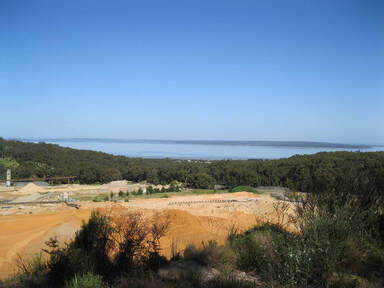 Sand Supplies mine, Gurdies Nature Conservation Reserve
Sand Supplies mine, Gurdies Nature Conservation Reserve BASS Coast Shire Council is calling on the State Government to fulfil its charter to protect the environment and biodiversity in the face of a surge in sand mining that threatens the shire’s last major forest.
In its submission on a draft Bass Coast Statement of Planning Policy (SPP), the council challenges the Government to put protection of biodiversity and threatened species first in the crucial 50-year plan for the shire.
The draft policy fails to acknowledge, let alone resolve, the inherent conflict between sand mining and the environment in the forest corridor between Lang Lang and Grantville, according to the council submission.
“It must recognise that extractive industries are a significant threat and are not consistent with section 46AN of the Planning and Environment Act 1987 that seeks the protection and conservation of the environment, including habitats, ecosystems and biodiversity.”
Councillors unanimously supported the submission at this week’s council meeting and it will now be forwarded to the Distinctive Area and Landscape (DAL) project team.
Announcing the DAL project in 2018, just weeks before the state election, Premier Daniel Andrews said it would protect Bass Coast's natural beauty and small-town lifestyle from unregulated development.
| Cr Rochelle Halstead said many saw the DAL project as a way to protect one of the last significant coastal forests in the Western Port region. “But it seems the Western Port Woodlands have been completely ignored by the Department of Environment, Land, Water and Planning. “I accept that licensees have a right under state legislation through their work authorities to continue their operations but this was an opportunity for the Victorian Government to make a change and put their money where their mouth is. “Words can’t describe the disappointment of the local community who have fought hard on this issue and should be encouraged to continue the fight.” The council submission acknowledges that extractive resources are crucial for the construction of public infrastructure as well as commercial and residential buildings, but says the Bass Coast resources are of lower priority than those in other areas of Victoria and mostly in areas of high strategic biodiversity. Victoria has a strong legislative and policy framework to protect biodiversity and threatened species, but enforcement is a different matter, particularly when it comes to extractive resource industries. | Council submission
|
“For Council to endorse the draft SPP, it must be amended to have a similarly strong position about the protection of the environmental values in the Lang Lang to Grantville Corridor. It must remove the threat of extractive resources by requiring extraction to be excluded from areas (private and public land) that support established native vegetation and which provides habitat for flora and fauna.”
The council requests mapping of a strategic biolink through the Lang Lang to Grantville Corridor to identiy areas where mining cannot occur.